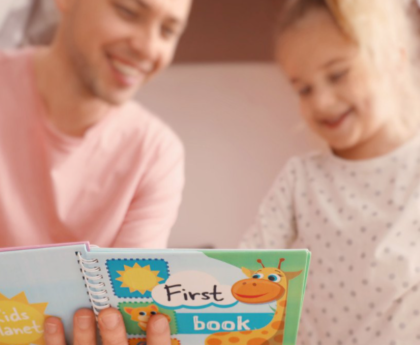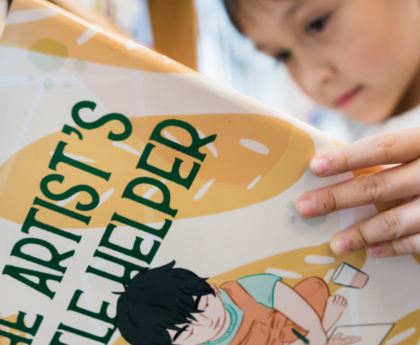Is your child struggling to understand new words in books as they learn to read? It’s common for beginner readers and their parents to feel discouraged. While building a strong vocabulary is an essential part of reading comprehension, it takes time. And it doesn’t have to be a chore.
To help your child discover a love for learning new words, here are ten engaging activities to help you make vocabulary building fun and effective at home.
How Do Children Develop Their Vocabulary?
Building a strong vocabulary is a fascinating part of language development that typically begins early in a child’s life. Here’s a glimpse into how children learn new vocabulary words:
- Exposure. Children learn their first words (and their meanings) by hearing them. The more words your child is exposed to in context, the greater their understanding of vocabulary becomes. Hearing stories read aloud, being involved in everyday conversations, and even listening to songs all play a role.
- Meaningful Context. Simply hearing a word isn’t enough to add it to one’s vocabulary. Children need to understand what the word means and how it’s used in order to properly learn it. This is why pictures, clear explanations, and engaging stories make new vocabulary stick for early readers.
- Interaction. Talking about new words and encouraging your child to use them appropriately solidifies their understanding of word meanings.
Explicit phonics instruction, exposure to a print-rich environment, and engaging in reading activities further support their vocabulary development.
10 Fun Activities for Building Your Child’s Vocabulary
Here are some engaging activities that make learning new words fun and effective.
1. Using the Reading.com App
The Reading.com app is an early literacy platform rooted in the science of reading. It’s designed for parents to use with their children to ensure engagement and correctness. Reading.com introduces new vocabulary in a scaffolded way so your child encounters new words at the right pace, building upon their existing knowledge.
2. Reading Aloud With Your Child
Reading aloud is effective and important for bonding at any age, from infants through teens. Make daily read-aloud sessions a part of your reading routine with your child. Choose books with a vocabulary that might be slightly above your child’s current proficiency. This exposes them to new words in a safe and engaging context.
Additionally, be willing to pause during read-alouds to discuss new, unfamiliar words. Explain new definitions and encourage your child to guess the meaning based on the surrounding text and illustrations.
3. Playing Description Games
Classic games like “I Spy” and “20 Questions” are fun ways to build vocabulary. In “I Spy,” take turns providing clues about an object in the room using descriptive vocabulary.
For example, instead of saying “I spy with my little eye… something yellow,” you could say “I spy with my little eye… something brightly colored that takes children to and from school.” In “20 Questions,” think of a word and let your child guess it by asking yes or no questions that require descriptive answers.
4. Turning Everyday Moments Into Learning Opportunities
Simple everyday tasks can be excellent vocabulary lessons. For example, while grocery shopping, encourage your child to name the different fruits and vegetables you encounter. Discuss their colors, shapes, and textures. Ask them to help you find specific ingredients on your shopping list, using descriptive words like “ripe bell peppers” or “long, green zucchini.”
Cooking in the kitchen is another great opportunity. Talk about the different spices you’re using and their unique flavors. Let your child help you measure ingredients, using words like “cup,” “teaspoon,” and “tablespoon.”
5. Rhyming and Wordplay
Playing with rhymes and silly word combinations can introduce children to new sounds and word structures. Read rhyming books filled with playful language, sing songs with fun wordplay, or make up silly stories together.
For example, you could create a story about a grumpy purple giraffe who loved to wear polka-dotted socks. This exposure to different sounds and rhythms helps children develop phonemic awareness, a crucial foundation for reading and vocabulary development.
6. Acting It Out
Charades and other acting games are other entertaining ways to challenge your child with new vocabulary words. When you encounter a new word in a book or conversation, see if your child can act it out. This back-and-forth play helps build vocabulary and strengthens communication skills in a fun and interactive way.
7. Labeling the World Around You
Create a word-rich environment at home by labeling furniture, objects, and rooms with clear and descriptive words. Keep it simple, using plain labels or colorful sticky notes. Even better, involve your child in the labeling process. Ask them to brainstorm words for different objects and encourage them to come up with their own descriptive terms. This empowers them to take ownership of their learning and reinforces new vocabulary in a practical way.
8. Creating Stories Together
Storytelling is a powerful tool for language development. Start by taking turns adding sentences to a collaborative story. You can begin with a simple prompt like “Once upon a time…” and see where your imaginations take you! As your child’s vocabulary grows, encourage them to create their own stories using newly-learned words. This helps them practice using words in context and strengthens their narrative skills.
9. Learning the Word of the Day
Create some kind of “Word of the Day” activity with your child at home. You can write the new word on a whiteboard, print out a word with an associated drawing, or identify the Word of the Day in a sentence. If your child uses the word of the day correctly, praise them and acknowledge their success in learning a new word.
10. Embracing Technology
Educational apps and games can be useful supplemental tools to classroom instruction. Look for apps specifically designed to build vocabulary in a fun and interactive way. The best educational apps align with the science of reading, focusing on explicit instruction and exposure to new words in meaningful contexts.
Play these games together and discuss the new words your child encounters. Many educational websites and online resources offer vocabulary-building activities and games, such as Reading.com!
More Vocab and Reading Activities for Kids
By adding some of these fun vocab activities to your daily routines, you help your child develop a strong vocabulary and foster a lifelong love for language.
Surround your child with a print-rich environment filled with books and magazines that cater to their interests. Make trips to the library and allow your child to explore different genres and topics. Most importantly, model a love for reading and learning yourself!
For more tips and activities designed specifically for early readers, download the Reading.com app today. Get started for free to see how your child’s vocabulary skills can improve in just a few sessions.





